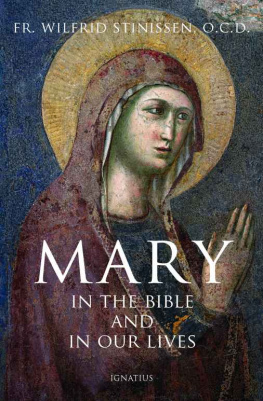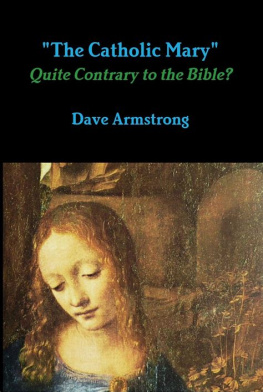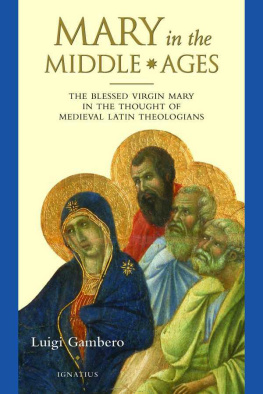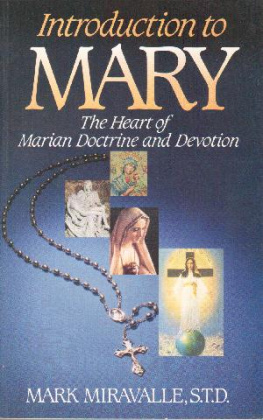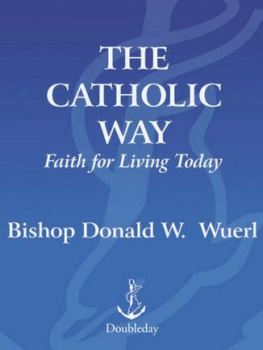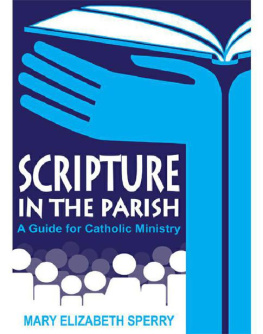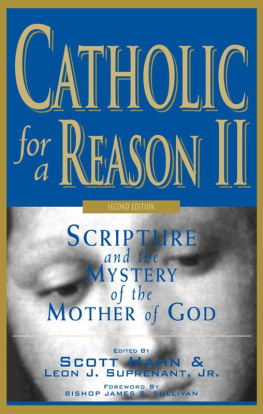MARY IN THE BIBLE
AND IN OUR LIVES
WILFRID STINISSEN, O.C.D.
Mary in the Bible
and in Our Lives

Translated by
Sister Clare Marie, O.C.D.
IGNATIUS PRESS SAN FRANCISCO
From the third edition of the Swedish original:
Maria i Bibleni vrt liv
1999 by Karmeliterna, Tgarp
Scripture quotations are from the Revised Standard Version of the BibleSecond Catholic Edition (Ignatius Edition) Copyright 2006 National Council of the Churches of Christ in the United States of America. Used by permission. All rights reserved worldwide.
Cover art:
Last Judgement , detail of the Virgin Mary
Pietro Cavallini (c. 12501330)
S. Cecilia in Trastevere, Rome, Italy
Scala/Art Resource, New York
Cover design by Roxanne Mei Lum
2018 by Ignatius Press, San Francisco
All rights reserved
ISBN 978-1-62164-187-2 (PB)
ISBN 978-1-68149-791-4 (EB)
Library of Congress Control Number 2017941602
Printed in the United States of America
Contents
2. Be It Done to Me
according to Your Word
1
Without Spot or Wrinkle
When we speak of the Immaculate Conception of the Blessed Virgin Mary, many, even among Catholics, think of the conception of Christ that occurred in Marys womb without harm to her virginity through a special intervention of the Holy Spirit. The Immaculate Conception of Mary is also truly a work of the Holy Spirit, but a work that took place in her at the very moment she came into being. Mary was free from original sin from the first moment of her existence. She was spared the contagion of the original sin that affects all of mankind. From the very beginning she was completely free of guilt.
Why This Privilege?
Let us first point out that the word privilege is not really fitting in this case. Privilege is related to private. The more privileges a person receives, the more he takes an exceptional position and distinguishes himself from others. But what Mary received, she received for others. Self-glorification was completely foreign to Mary. She never desired to be greater than others, as many of us do. That is why theologians have often done her a disservice by adorning her with every possible privilege, making her an extremely exalted creature with whom one can no longer have any human relationship.
The liturgical texts used by the Church on the Solemnity of the Immaculate Conception (December 8) clearly express why Mary was preserved from the guilt of original sin and all other sin. The Church says to the Father: O God, who by the Immaculate Conception of the Blessed Virgin prepared a worthy dwelling for your Son (Collect). Mary was predestined to be the Mother of God. God chose her to give birth, by the power of the Holy Spirit, to a child who was Gods own Son, indeed like us in all things but without sinning (Heb 4:15). How could she have been a worthy partner of the Holy Spirit and given birth to an immaculate Son if she herself had not been without sin? God willed that Jesus would receive from her everything a child normally receives from his mother: not merely his physical body, but also his hereditary disposition, his temperament, his whole psyche. It was part of Gods plan that the Son would receive his life unconditionally from his Mother: nothing in her would be rejected, nothing excluded. Mary was so holy through and through that she could give herself totally to her child. Any other arrangement would have created a distance between Mother and Son, a distance that could have implied that God did not accept all the consequences of being human.
The liturgy also says Mary was preserved from sin so that in her, endowed with the rich fullness of your grace, you might prepare a worthy Mother for your Son and signify the beginning of the Church, his beautiful Bride without spot or wrinkle (preface). Mary is not only the Mother of Jesus. When she stood at the foot of the Cross, she became the New Eve. There she stood in a bridal relationship to the New Adam. The Church that God sees as the Bride of Christ (cf. 2 Cor 11:2, Eph 5:23ff.) is not only a collection of individuals. She is embodied in a concrete, living person. When Jesus gave himself on the Cross, the Church was not absent, she was present in Mary. If Mary had not been immaculate, she could never have been an image of the Church, the pure Virgin, without spot or wrinkle (Eph 5:27).
An Absolute Yes
But in reality, Thrse, without knowing it, often gave in to a certain self-centeredness. Her conscious Yes could not have been without many small, unconscious Nos. Marys Yes, on the other hand, filled not only her consciousness, but her entire being. She was a living Yes, Father. Her Yes poured forth spontaneously from her unconscious. She did not need to force it, because saying Yes was her life.
The more Mary said Yes, the greater her inner capacity grew. We can imagine she felt a particular joy when she prayed or heard the Psalm verse you have opened my heart. God predestined her to say a Yes that would be the response of all mankind to his invitation. God respects mans freedom in his relationship with him. Again and again, God made a covenant with man. He considered him a genuine partner in his covenant. When the moment of the Incarnation arrived, and God wished to say his final Yes to man, he wanted to give him the possibility of responding with a Yes that was equally definitive and unconditional. No sinful human being is capable of such a response, but Mary was prepared for it by this Yes-disposition that had been imprinted in her being from the beginning. With her created, but no less absolute, Yes, Gods divine Yes could enter into a marriage, the fruit of which would be Jesus, the Savior of the world. Just as Gods Yes concerned all mankind, so Marys Yes was received as the response of all mankind.
The Perfect Human Being
While we readily flee into abstractions, it seems nothing lies nearer to Gods heart than being concrete. The Incarnation is almost a frightening proof of that. It is easier for us to accept an abstract, distant, and thus harmless God than a God who comes close to us and who through concrete, unambiguous actions shows us how he is and how we can follow him. We have an incurable tendency to transform the concrete ideal into ideologies. God, on the other hand, knows that reality is never abstract. That is why he does not allow man to strive for abstract goals that are attained only when the full development process is finished. He usually gives us a concrete image of the goal at the beginning of the journey. Before we start off, we are allowed to behold and often even experience something of what we shall receive at the end of our journey. Aristotles principle, that the goal is the first thing one holds in ones mind, even if it is the final reality, is only a watered down version of Gods principle, according to which the goal is there from the beginning, not only as an intention, but to a certain degree also as a concrete reality. When Jesus warns us: Unless you turn and become like children, you will never enter the kingdom of heaven (Mt 18:3), we all understand what he means. As children, we have experienced a condition of complete dependency and total surrender. This condition must be recaptured, but now consciously and freely. When depth psychology claims that man unconsciously longs to return to the original security of the mothers womb, it reveals something of the pedagogy of the Creator. The last is always first. The last is anticipated in the first, so that we will have certain, clear reference points on the long journey toward the goal.
One is able to experience in a transitory and more peripheral way even here what becomes a definitive reality in total union (the sixth mansion): It is no longer I who live, but Christ who lives in me (Gal 2:20).
Next page
